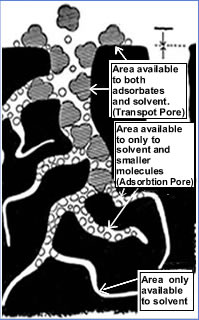Activated Carbons are the most powerful adsorbents known. It is basically a solid material consisting mainly of pure carbon. A characteristic feature is its porous structure and the resulting immense surface area which may be as large as 1500 m2/gm. Due to its exceptional adsorption qualities, activated carbon is widely used in process destined to purify, discolor, recuperate and remove odors at low cost and superior efficiency. Activated carbons work on the principle of adorption. Adsorption is an interfacial process involving the collection of gaseous or solute components on the surface of adsorbent solids. This phenomenon is associated with physical attractive forces that bind gaseous and solute molecules commonly known as Van-der-Waals forces. Adsorption is thus a physical process, i.e. the substances adsorbed on the solid do not undergo any chemical reaction with the latter. The adsorbing solid is referred to as adsorbent and the substance to be adsorbed from the liquid or the gas phase as the solute.
The adsorption power and rate is determined by the kind of activated carbon, the particle size, the pore size and its distribution.
